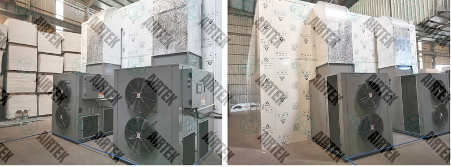Professional food processing, such as those provided by a fruit dryer machine, demands precision that traditional drying methods simply cannot deliver. Modern commercial operations face mounting pressure to produce consistently high-quality dried fruits that meet stringent market standards while maintaining profitability.
The sophisticated technology within a fruit dryer machine revolutionises the entire drying process through meticulous environmental control. These advanced systems eliminate the guesswork and variability that plague conventional drying methods, ensuring every batch meets exacting quality specifications.
Understanding Precision Control Systems
- Temperature Regulation Excellence: Modern fruit drying equipment incorporates multi-zone temperature control systems that maintain precise heat distribution throughout the drying chamber. These systems prevent hotspots that cause scorching whilst ensuring adequate heat penetration for thorough moisture removal. The result eliminates product loss from temperature-related defects.
- Humidity Management Perfection: Controlled humidity levels prevent case-hardening, where fruit surfaces dry too quickly and trap moisture inside. Advanced dehumidification systems extract moisture at optimal rates, preserving cellular structure and preventing the tough, leathery texture that reduces product value significantly.
- Airflow Optimisation Technology: Precisely calibrated air circulation patterns ensure uniform exposure across all drying surfaces. Strategic airflow design eliminates dead zones where moisture accumulates, preventing mould development and ensuring consistent drying rates throughout the entire chamber.
Achieving Uniform Drying Results
- Multi-Tray Consistency Systems: Professional drying equipment features rotating tray mechanisms or advanced air distribution networks that guarantee equal treatment for all product layers. This technology eliminates the need for manual rotation whilst ensuring top and bottom trays receive identical drying conditions.
- Load Balancing Capabilities: Smart sensors monitor moisture levels across different tray positions, automatically adjusting airflow and temperature to compensate for varying load densities. This intelligent system prevents over-drying in lighter areas whilst ensuring complete moisture removal from denser sections.
- Quality Monitoring Integration: Real-time moisture sensors provide continuous feedback about drying progress, preventing the under-processing that leads to spoilage or over-processing that destroys valuable nutrients. These monitoring systems guarantee optimal endpoint determination for every batch.
Preventing Common Drying Problems
- Discolouration Prevention Methods: Controlled oxygen environments and precise temperature management prevent enzymatic browning that destroys visual appeal. Advanced systems create optimal conditions that preserve natural colours whilst achieving target moisture levels efficiently and reliably.
- Structural Integrity Maintenance: Gradual moisture removal rates prevent cellular collapse that causes shrivelling and deformation. Professional equipment maintains fruit shape and size consistency, delivering products that command premium prices in competitive markets.
- Nutrient Preservation Techniques: Lower processing temperatures combined with reduced drying times preserve heat-sensitive vitamins and antioxidants. This approach maintains nutritional value whilst achieving shelf-stable moisture content, meeting consumer demands for healthy products.
Commercial Quality Standards Compliance
- Regulatory Requirement Adherence: Professional drying systems meet food safety regulations through documented process controls and temperature logging capabilities. These features provide the traceability documentation required for commercial food production and export certification processes.
- Consistency Assurance Protocols: Automated process controls eliminate human error variables that cause batch-to-batch variations. Standardised operating parameters ensure every production run meets identical quality specifications, reducing rejection rates and maintaining customer satisfaction levels.
- Market Readiness Guarantees: Products processed through controlled drying systems exhibit superior rehydration properties and extended shelf life compared to traditionally dried alternatives. These quality advantages translate directly into competitive market positioning and increased profitability margins.
Advanced Technology Benefits
Energy Efficiency Optimisation: Modern drying systems incorporate heat recovery technology and variable-speed components that reduce operating costs significantly. Lower energy consumption per unit of processed product improves profit margins whilst supporting environmental sustainability goals.
Processing Speed Enhancement: Controlled environments enable faster moisture removal without quality compromise, increasing throughput capacity for existing facilities. Higher production volumes reduce per-unit processing costs whilst meeting growing market demand effectively.
- Automated Operation Features: Programmable control systems reduce labour requirements through automated startup, monitoring, and shutdown sequences
- Remote Monitoring Capabilities: Internet connectivity enables off-site supervision and troubleshooting, reducing downtime and maintenance costs substantially
- Data Logging Systems: Comprehensive process documentation supports quality assurance programmes and regulatory compliance requirements efficiently
- Predictive Maintenance Alerts: Smart diagnostic systems identify potential issues before equipment failures occur, preventing costly production interruptions
Return on Investment Considerations
- Product Loss Reduction: Controlled drying environments virtually eliminate spoilage from mould, over-drying, or under-processing that plague traditional methods. Reduced waste directly improves bottom-line profitability whilst ensuring consistent product availability for customers.
- Premium Pricing Opportunities: Superior product quality enables positioning in high-value market segments that command premium prices. Consistent appearance, texture, and nutritional content justify higher selling prices compared to inferior alternatives.
- Operational Efficiency Gains: Automated systems reduce labour requirements whilst increasing processing capacity, improving overall operational efficiency. Lower staffing costs combined with higher throughput create substantial competitive advantages in price-sensitive markets.
Quality Assurance Integration
- Process Documentation Systems: Comprehensive logging capabilities create detailed records of every processing parameter for each batch. This documentation supports quality management systems whilst providing traceability information required for premium market positioning.
- Consistency Verification Methods: Built-in quality control features enable real-time monitoring of critical parameters that affect final product quality. Early detection of variations allows immediate corrections before entire batches become compromised.
- Customer Satisfaction Enhancement: Consistent product quality reduces customer complaints whilst building brand reputation for reliability. Satisfied customers provide repeat business and referrals that drive long-term growth and profitability.
Conclusion
Professional fruit processing operations cannot afford the inconsistency and quality risks associated with traditional drying methods. Advanced fruit dryer machine technology delivers the precision control necessary for producing consistently superior products that meet demanding commercial standards. The investment in proper drying equipment pays dividends through reduced waste, premium pricing opportunities, and enhanced customer satisfaction levels. Take action today to evaluate how controlled drying technology can transform your processing operations and deliver the quality advantages your business needs to thrive in competitive markets.

